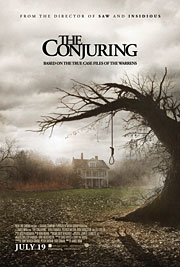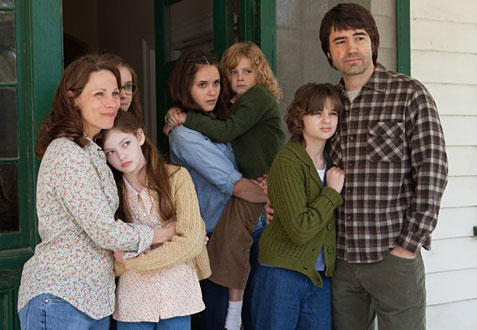
The strange thing about horror movies of the last 10 years is that they’ve rarely been scary. They’ve been grotesque – take, please, “Evil Dead” from earlier this year – but few of them have been legitimately frightening. “The Conjuring,” on the other hand, understands that violence is not horror, and delivers a truly disturbing viewing experience. It may use a little Hollywood pixie dust to make it to the finish line, but the pre-Hollywood psychodrama is positively chilling, and the use of old-school techniques only adds to the creep factor.
It’s the fall of 1971, and Roger and Carolyn Petton (Ron Livingston and Lili Taylor), along with their five daughters, are moving into an old farm house in Rhode Island. From the very beginning, the place seems a little off (the dog won’t go in the house, the basement is boarded up), but the family puts up with all of the seemingly unrelated annoyances (cold, the occasional foul stench, youngest daughter April’s new imaginary friend) and attributes it to, well, something rational, something explainable. It is not long, though, before the “house” ramps up the offensive, and an exasperated Carolyn asks local paranormal researchers Lorraine and Ed Warren (Vera Farmiga and Patrick Wilson) to come to the house and evaluate their problem. Lorraine, a clairvoyant, gets bad vibes from the very beginning, and after doing a little research on the former homeowners, she is fearful for the lives of the entire Perron family, Carolyn in particular.
Screenwriting twins Chad and Carey Hayes wrote the script of their lives here – though to be fair, one look at their IMDb profile and you’ll see that that is a backhanded compliment – by framing the ‘A’ story (the Perrons) and the ‘B’ story (the Warrens) side by side until such time that the families can come together organically. It’s a shrewd move, because it gives the audience the occasional, much-needed break from the terror that the Perrons are suffering, while slowly allowing the audience to get to know the Warrens and the, um, ghosts of their past that they bring with them to this case. That, plus Wan’s refusal to resort to the cheap ‘boo’ scare, gets the audience emotionally invested early, and never lets them go.
Lorraine makes several decisions of the ‘don’t you go in there’ variety, and it’s actually awesome to see, because they make sense; she’s not afraid of what she’s dealing with, so of course she would do what she does here. Likewise, Roger and Carolyn walk into a boarded basement because, hey, it’s 1971. The age of irony hasn’t happened yet, and they have no reason to suspect that they just bought a haunted house. Present-day audiences may scoff – and ours did – but they forget: the people they’re watching don’t realize they’re in a horror movie.
Director James Wan must be a big fan of “Poltergeist,” because similarities abound between the two films, right down to the shot of the static-filled TV screen. And really, if you’re going to pay homage to a scary movie, that’s as good as they get. His effects are simple and direct, with only a handful of CGI involved. There is also a minimal amount of language and blood, meaning that this movie earned its ‘R’ rating the hard way. That’s downright noble anymore.
Having said that, the final act is a bit over the top. There are children in peril, an unlikely hero, the protagonists staring into the face of evil…these are all cornerstones of thrillers and horror movies, and artistic license was surely taken with both the events and the timing of said events. Still, it’s an easy thing to forgive that late in the game, and any filmmaker will tell you not to let the truth get in the way of a good story, since the truth would almost certainly have been a lot less interesting. With any luck, “The Conjuring” will lead potential future horror filmmakers raised on a diet of torture porn and slasher films to rethink their approach. One can hope, at least.
Related Posts
Posted in: Entertainment, Movie Reviews, Movies
Tags: James Wan, Patrick Wilson, The Conjuring, The Conjuring review, Vera Farmiga
















